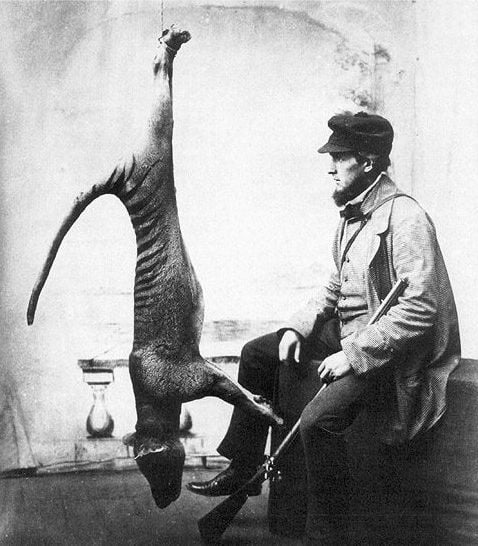Remembering the Tasmanian Tiger, 80 Years After It Became Extinct
Today, the animal’s memory is alive and well in Australia
/https://tf-cmsv2-smithsonianmag-media.s3.amazonaws.com/filer/53/b4/53b4f24b-4b03-49ba-a6eb-f38db2190f9f/-benjamin-.jpg)
Eighty years ago today, the last Tasmanian tiger died in the Hobart Zoo. It was called Benjamin.
Video footage of the Tasmanian tiger, or thylacine, captures an unusual creature. Bobbing its head and glancing at the camera, it doesn’t seem much like a carnivore—until it yawns, revealing an improbably large mouth with pointed teeth.
Its movements aren’t the lithe swagger you might expect from a feline. But that makes sense: despite its deceptive name, the thylacine was a large marsupial, about the size of a dog. It got the name “tiger” because of the stripes that ran down its body.
The last thylacine’s death came about because a zookeeper forgot to lock it in its shelter one night and it died of exposure, a release by the Australian government states. Whether that’s true or not, this story about the thylacine is illustrative of a dark chapter in Australia’s environmental history.
Besides habitat destruction and other factors associated with settlement in Tasmania, thylacines were actively hunted. Bounty systems for the thylacine were established as early as 1830. Ironically, a 2011 study published in the Journal of Animal Ecology found that the thylacine likely wasn’t strong enough to hunt sheep—one of the rationales behind the thylacine bounty.

Though the last recorded kill of the animal in the wild came in 1930, the Tasmanian government finally granted protected status to the thylacine in 1936, just 59 days before Benjamin’s death. Though it took another 50 years for the species to be officially declared extinct, the writing was on the wall for the thylacine back in 1851. As naturalist John Gould observed then:
When the comparatively small island of Tasmania becomes more densely populated, and its primitive forests are intersected with roads from the eastern to the western coast, the numbers of this singular animal will speedily diminish, extermination will have its full sway, and it will then, like the Wolf in England and Scotland, be recorded as an animal of the past...
Today, Tasmanian tigers are alive and well in urban myth throughout Australia. The animal once existed on mainland Australia as well, but there it was in competition with the dingo, Richard Macey reports for The Sydney Morning Herald, which spelled an earlier end for the tiger by some 3000 years.
Still, most recently, a video released on the Thylacine Awareness Group’s Youtube channel claimed to show one of the extinct creatures in an Adelaide suburb. Like numerous other claimed sightings over the decades, this one is unconfirmed, reports The Advertiser.
Talk about bringing thylacines back via cloning has also surfaced in recent years, although plans by the Australian Museum were abandoned in 2005 and the ethics of de-extinction are an open conversation.
At present, though, the easiest place to see a thylacine is on the Tasmanian coat of arms.
